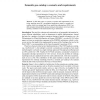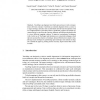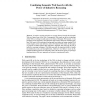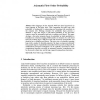SEMWEB
2009
Springer
14 years 6 months ago
2009
Springer
In this paper we present a scenario for ontology matching posed by the Trentino Riscossioni S.p.A data integration system focusing the opportunity to enhance the level of data inte...
SEMWEB
2009
Springer
14 years 6 months ago
2009
Springer
Abstract. In this short paper we present a scenario and requirements for ontology matching posed by a geographical application, namely a semantic geocatalog, which is an integral p...
SEMWEB
2009
Springer
14 years 6 months ago
2009
Springer
Abstract. TaxoMap is an alignment tool which aims to discover rich correspondences between concepts. It performs an oriented alignment (from a source to a target ontology) and take...
SEMWEB
2009
Springer
14 years 6 months ago
2009
Springer
The Family History Knowledge Base (FHKB) was presented at OWLED in 2008. The FHKB uses a rich object property hierarchy, including many OWL 2 features, to derive many entailments o...
SEMWEB
2009
Springer
14 years 6 months ago
2009
Springer
A semantic application typically is a heterogenous system of interconnected components, most notably a reasoner. OWLlink is an implementation-neutral protocol for communication bet...
SEMWEB
2009
Springer
14 years 6 months ago
2009
Springer
Abstract The current OWL 2 specification provides mechanisms for importing whole ontologies. This paper discusses the import of only a module of an external ontology, which is spe...
SEMWEB
2009
Springer
14 years 6 months ago
2009
Springer
Extensive research activities are recently directed towards the Semantic Web as a future form of the Web. Consequently, Web search as the key technology of the Web is evolving towa...
SEMWEB
2009
Springer
14 years 6 months ago
2009
Springer
Most languages for the Semantic Web have their logical basis in some fragment of first-order logic. Thus, integrating first-order logic with probability is fundamental for represen...
SEMWEB
2009
Springer
14 years 6 months ago
2009
Springer
The OWL is a language for representing ontologies but it is unable to capture the uncertainty about the concepts for a domain. To address the problem of representing uncertainty, w...
SEMWEB
2009
Springer
14 years 6 months ago
2009
Springer
Linked open data offers a set of design patterns and conventions for sharing data across the semantic web. In this position paper we enumerate some key uncertainty representation i...




